
DRSSTC V ( now "Skinny Coil" )
Phillip Slawinski, Mon Nov 23 2015, 04:08AMI posted about my DRSSTC V back in 2010 ... Since then I've updated it a little bit. I cut out all the crappy bits, and i put in one of Steve Ward's Universal Drivers (V3). I also went from 120V power to 240V ... the results were pretty neat, so I thought I'd share...
Thanks to Steve Ward for making the UD3!
Re: DRSSTC V ( now "Skinny Coil" )
Mads Barnkob, Mon Nov 23 2015, 02:15PM
That is some really great and spectacular sparks. Could you link to the original post about the coil or give the specifications on it again?
I have been working on something similar, thou a fres at 100 kHz. I am however aiming at longer on-times.
Is the UD3 a official and public thing now or reserved for Ward and friends? ;)
The UD3 got a qcw-like mode?
Mads Barnkob, Mon Nov 23 2015, 02:15PM
That is some really great and spectacular sparks. Could you link to the original post about the coil or give the specifications on it again?
I have been working on something similar, thou a fres at 100 kHz. I am however aiming at longer on-times.
Is the UD3 a official and public thing now or reserved for Ward and friends? ;)
The UD3 got a qcw-like mode?
Re: DRSSTC V ( now "Skinny Coil" )
Steve Ward, Mon Nov 23 2015, 05:08PM
I'm considering making it more available as time goes on... reasons for keeping it more private for now is that it's a rather complicated beast, and i don't have the motivation to support too many users. If people think its worth the cost (i think the BOM is nearly $100 USD + the need for a Cypress PSoC Programmer) and aren't scared off by the words "serial communications" or "microcontroller programming" or "TQFP soldering" then I'm usually pretty happy to put it into the hands of a caring Tesla Coiler . I'm not going to get rich off selling tesla coil drivers (especially complicated ones), so my only motivation is to see what others can create.
. I'm not going to get rich off selling tesla coil drivers (especially complicated ones), so my only motivation is to see what others can create.
The UD3 has been used in basically all types of solid state coil. Main advancements are digitally controlled phase lead, pulse skip (aka freewheeling) current limiting (which allows for long pulse duration even with ground arcs), phase-shift bridge modulation for QCW, and the use of a serial
interface which can allow things like directly sending MIDI data to it. It uses a Cypress PSoC 5LP as the brains.

It's a neat chip, but certainly has a lot of undocumented quirks and i often run into limits on the programmable logic. There is likely a more capable chip out there now, but years of development have already been invested and "it works".
Ok, enough thread hi-jacking.
Steve Ward, Mon Nov 23 2015, 05:08PM
Is the UD3 a official and public thing now or reserved for Ward and friends? ;)
The UD3 got a qcw-like mode?
I'm considering making it more available as time goes on... reasons for keeping it more private for now is that it's a rather complicated beast, and i don't have the motivation to support too many users. If people think its worth the cost (i think the BOM is nearly $100 USD + the need for a Cypress PSoC Programmer) and aren't scared off by the words "serial communications" or "microcontroller programming" or "TQFP soldering" then I'm usually pretty happy to put it into the hands of a caring Tesla Coiler
 . I'm not going to get rich off selling tesla coil drivers (especially complicated ones), so my only motivation is to see what others can create.
. I'm not going to get rich off selling tesla coil drivers (especially complicated ones), so my only motivation is to see what others can create.The UD3 has been used in basically all types of solid state coil. Main advancements are digitally controlled phase lead, pulse skip (aka freewheeling) current limiting (which allows for long pulse duration even with ground arcs), phase-shift bridge modulation for QCW, and the use of a serial
interface which can allow things like directly sending MIDI data to it. It uses a Cypress PSoC 5LP as the brains.

It's a neat chip, but certainly has a lot of undocumented quirks and i often run into limits on the programmable logic. There is likely a more capable chip out there now, but years of development have already been invested and "it works".
Ok, enough thread hi-jacking.
Re: DRSSTC V ( now "Skinny Coil" )
Sulaiman, Mon Nov 23 2015, 07:10PM
Phillip Slawinski; WOW !
Those are excellent sparks and arcs,especially relative to TC dimensions.
I'm jealous.
Sulaiman, Mon Nov 23 2015, 07:10PM
Phillip Slawinski; WOW !
Those are excellent sparks and arcs,especially relative to TC dimensions.
I'm jealous.
Re: DRSSTC V ( now "Skinny Coil" )
Phillip Slawinski, Mon Nov 23 2015, 09:38PM
I can't find the post where I gave specs for this coil, only some of the earlier iterations.
 -- I think only the small toroid on this coil is original to that system.
-- I think only the small toroid on this coil is original to that system.
Anyway ... F0 on this coil is about 104kHz. I'm running a .15µF tank cap, and I think something around 12µH of primary inductance. I recently remade the primary supports from G-10, previously they were delrin which got a little bit melty on me. The G-10 is absolutely necessary now, as the primary gets in excess of 100ºC. The primary is pretty much the only thing aside from the secondary that gets notably warm though.
The secondary has a roughly 12" winding (some turns have been removed due to flash overs ;) ). The secondary is wound with #34 AWG. The secondary unloaded frequency is somewhere in the neighborhood of 140kHz
The bridge inside is comprised of 2 CM300DY-12NF bricks. I have the limiter set at 550A and it actually limits to about 640A (measured). To make the sparks in the video requires about 4kW (input current varies between 11-19A depending on spark loading).
Presently I'm limited by the ceiling in terms of spark length. As you can see from the video, once the bus voltage is turned all the way up, it has absolutely zero problems making 66" sparks.
Phillip Slawinski, Mon Nov 23 2015, 09:38PM
I can't find the post where I gave specs for this coil, only some of the earlier iterations.
 -- I think only the small toroid on this coil is original to that system.
-- I think only the small toroid on this coil is original to that system. Anyway ... F0 on this coil is about 104kHz. I'm running a .15µF tank cap, and I think something around 12µH of primary inductance. I recently remade the primary supports from G-10, previously they were delrin which got a little bit melty on me. The G-10 is absolutely necessary now, as the primary gets in excess of 100ºC. The primary is pretty much the only thing aside from the secondary that gets notably warm though.
The secondary has a roughly 12" winding (some turns have been removed due to flash overs ;) ). The secondary is wound with #34 AWG. The secondary unloaded frequency is somewhere in the neighborhood of 140kHz
The bridge inside is comprised of 2 CM300DY-12NF bricks. I have the limiter set at 550A and it actually limits to about 640A (measured). To make the sparks in the video requires about 4kW (input current varies between 11-19A depending on spark loading).
Presently I'm limited by the ceiling in terms of spark length. As you can see from the video, once the bus voltage is turned all the way up, it has absolutely zero problems making 66" sparks.
Re: DRSSTC V ( now "Skinny Coil" )
Phillip Slawinski, Tue Nov 24 2015, 04:06AM
More testing... This time with low break rate and higher pulse length. Pretty neat results. Got the spark length up to six feet. That's a little more than 6 times the secondary winding length. Not too bad, I think.
If you click on the images below you can see the full 56MP image. Definitely recommended for the image of the coil flashing over
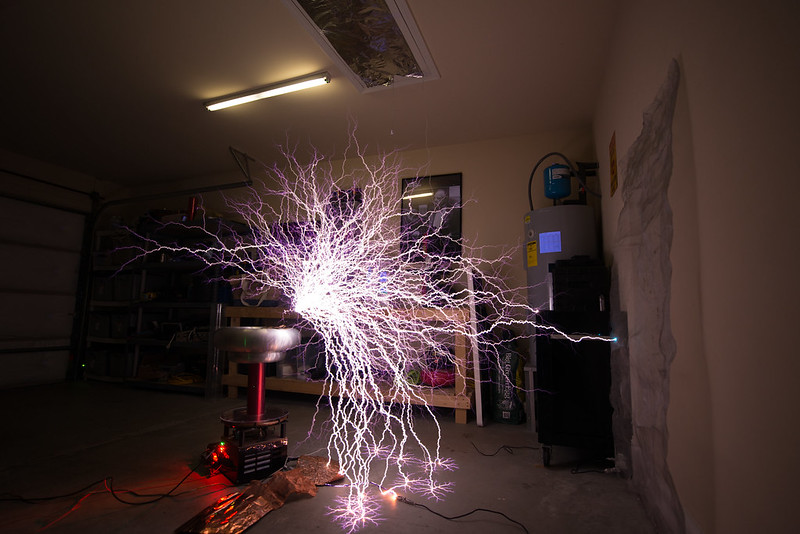
Things got a little hairy...
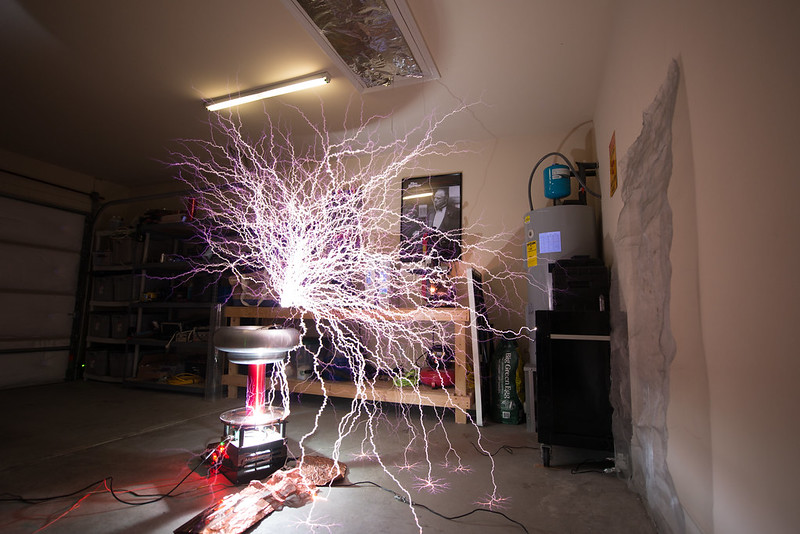
Pretty soon afterwards this happened:
No big deal really, just removed a few more turns and cleaned off the carbon should be good for more testing tomorrow.
Phillip Slawinski, Tue Nov 24 2015, 04:06AM
More testing... This time with low break rate and higher pulse length. Pretty neat results. Got the spark length up to six feet. That's a little more than 6 times the secondary winding length. Not too bad, I think.
If you click on the images below you can see the full 56MP image. Definitely recommended for the image of the coil flashing over


Things got a little hairy...

Pretty soon afterwards this happened:
No big deal really, just removed a few more turns and cleaned off the carbon should be good for more testing tomorrow.
Re: DRSSTC V ( now "Skinny Coil" )
loneoceans, Tue Nov 24 2015, 07:37AM
Great job phil :) I bet that secondary still has some life left! Long powerful single-shot pulses are always nice to see. I've always wanted to do like a 'bullet time' thing to see the 3D form of a single bushy spark. Looking forward to more!
loneoceans, Tue Nov 24 2015, 07:37AM
Great job phil :) I bet that secondary still has some life left! Long powerful single-shot pulses are always nice to see. I've always wanted to do like a 'bullet time' thing to see the 3D form of a single bushy spark. Looking forward to more!
Re: DRSSTC V ( now "Skinny Coil" )
Mads Barnkob, Tue Nov 24 2015, 08:42AM
You had me scared off already :) I can understand that it remains in a closed circle when its not a straight forward design that everyone from the street can use. You would have to sell pre-soldered/pre-programmed boards for it to make sense.
Mads Barnkob, Tue Nov 24 2015, 08:42AM
Steve Ward wrote ...
I'm considering making it more available as time goes on... reasons for keeping it more private for now is that it's a rather complicated beast, and i don't have the motivation to support too many users. If people think its worth the cost (i think the BOM is nearly $100 USD + the need for a Cypress PSoC Programmer) and aren't scared off by the words "serial communications" or "microcontroller programming" or "TQFP soldering" then I'm usually pretty happy to put it into the hands of a caring Tesla Coiler . I'm not going to get rich off selling tesla coil drivers (especially complicated ones), so my only motivation is to see what others can create.
. I'm not going to get rich off selling tesla coil drivers (especially complicated ones), so my only motivation is to see what others can create.
The UD3 has been used in basically all types of solid state coil. Main advancements are digitally controlled phase lead, pulse skip (aka freewheeling) current limiting (which allows for long pulse duration even with ground arcs), phase-shift bridge modulation for QCW, and the use of a serial
interface which can allow things like directly sending MIDI data to it. It uses a Cypress PSoC 5LP as the brains.

It's a neat chip, but certainly has a lot of undocumented quirks and i often run into limits on the programmable logic. There is likely a more capable chip out there now, but years of development have already been invested and "it works".
Ok, enough thread hi-jacking.
Is the UD3 a official and public thing now or reserved for Ward and friends? ;)
The UD3 got a qcw-like mode?
I'm considering making it more available as time goes on... reasons for keeping it more private for now is that it's a rather complicated beast, and i don't have the motivation to support too many users. If people think its worth the cost (i think the BOM is nearly $100 USD + the need for a Cypress PSoC Programmer) and aren't scared off by the words "serial communications" or "microcontroller programming" or "TQFP soldering" then I'm usually pretty happy to put it into the hands of a caring Tesla Coiler
 . I'm not going to get rich off selling tesla coil drivers (especially complicated ones), so my only motivation is to see what others can create.
. I'm not going to get rich off selling tesla coil drivers (especially complicated ones), so my only motivation is to see what others can create.The UD3 has been used in basically all types of solid state coil. Main advancements are digitally controlled phase lead, pulse skip (aka freewheeling) current limiting (which allows for long pulse duration even with ground arcs), phase-shift bridge modulation for QCW, and the use of a serial
interface which can allow things like directly sending MIDI data to it. It uses a Cypress PSoC 5LP as the brains.

It's a neat chip, but certainly has a lot of undocumented quirks and i often run into limits on the programmable logic. There is likely a more capable chip out there now, but years of development have already been invested and "it works".
Ok, enough thread hi-jacking.
You had me scared off already :) I can understand that it remains in a closed circle when its not a straight forward design that everyone from the street can use. You would have to sell pre-soldered/pre-programmed boards for it to make sense.
Re: DRSSTC V ( now "Skinny Coil" )
Phillip Slawinski, Wed Nov 25 2015, 04:07AM
Ran up to 7ms pulses today. Easily doing 72+ inches now. This coil is looking more and more like it was cobbled together now.

No ... your'e not seeing things, I did put another toroid on top of the toroids. My breakout point was "leaky" so I just took a spare toroid and plopped it up there, problem solved.
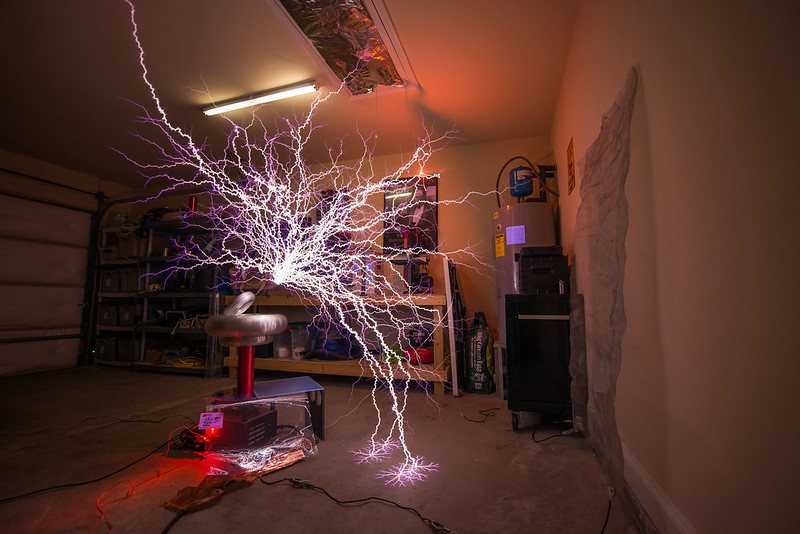
Hit the garage door opener ... oops. Fortunately it survived.
Phillip Slawinski, Wed Nov 25 2015, 04:07AM
Ran up to 7ms pulses today. Easily doing 72+ inches now. This coil is looking more and more like it was cobbled together now.

No ... your'e not seeing things, I did put another toroid on top of the toroids. My breakout point was "leaky" so I just took a spare toroid and plopped it up there, problem solved.

Hit the garage door opener ... oops. Fortunately it survived.
Re: DRSSTC V ( now "Skinny Coil" )
Phillip Slawinski, Tue Mar 29 2016, 03:54AM
Been a while since I updated this thread, and since the last update I basically rebuilt the entire coil. I've dubbed the new creation "Skinny Coil." This name is a play off of the name Steve Ward gave to his "Fat Coil DRSSTC."
I'm still using the same secondary (because I'm stubborn and don't want to wind a new one). The secondary has been burnt several times, and I've just rewound the *wrong* gauge wire on there every time :) The secondary resonates at 136kHz now with no spark load. The primary is tuned to 104kHz, and that's where it runs (verified by scoping primary current). I rebuilt my MMC with some beefier caps, and now it's up to .156µF. The previous MMC was .15µF, so this isn't much of an increase.
I got rid of the crap Delrin primary supports after they melted. Now I have G-10 supports. Unfortunately the G-10 wasn't enough to handle the temperatures reached by running 175A RMS, so I ended up water cooling the primary. The primary is much happier now that it has cool water flowing through it. The water cooling doesn't stop at the primary though. I had to water cool the bridge as well, since the heatsink was getting to 40ºC with <1minute run time.
I'm now running a PFC designed by Steve Ward. Water cooled -- of course. The water cooling system has around 1.5 liters of water in it, and is circulated with a D5 (strong) pump. This is fed through a 2x120mm radiator and I use 2x PFB1224UHE fans. If you're not familiar with the UHE series fans ... they REALLY blow. You can't run these fans on the bench without securing them, or they will blow themselves away. They're also incredibly loud. Good thing they're installed on a Tesla Coil, so the loudness doesn't matter ;)
The coil runs about 4kW average power. 360V bus, CM300DY-12NF full bridge.
Here's a crummy photo of the coil base:
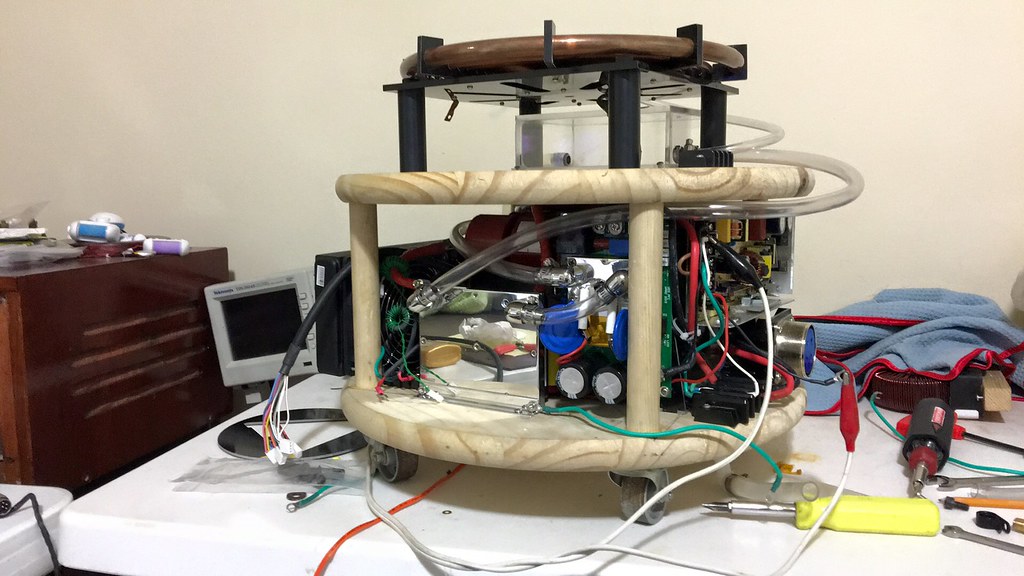
This photo was taken when the coil was being worked on so it's not completely assembled. You can see the boost inductor below the blue towel on the right side of the photo. The boost inductor typically is located directly behind the big water block for the IGBTs.
Photo of the water blocks:
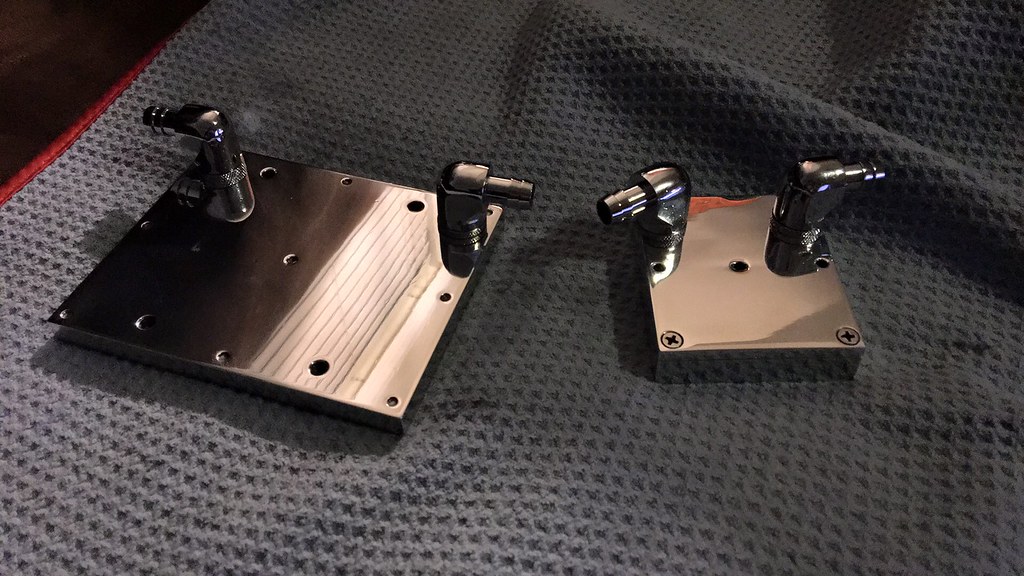
I used aluminum because it's easy to machine on the CNC router I have access to. Ideally I'd have used something like copper that is more compatible with the other metals in the water loop ... but oh well.
Here's a photo of a CM300 I killed because I had a loose GDT connection.

Oh and here's some video of the thing in action...
Other videos are on my page:
Phillip Slawinski, Tue Mar 29 2016, 03:54AM
Been a while since I updated this thread, and since the last update I basically rebuilt the entire coil. I've dubbed the new creation "Skinny Coil." This name is a play off of the name Steve Ward gave to his "Fat Coil DRSSTC."
I'm still using the same secondary (because I'm stubborn and don't want to wind a new one). The secondary has been burnt several times, and I've just rewound the *wrong* gauge wire on there every time :) The secondary resonates at 136kHz now with no spark load. The primary is tuned to 104kHz, and that's where it runs (verified by scoping primary current). I rebuilt my MMC with some beefier caps, and now it's up to .156µF. The previous MMC was .15µF, so this isn't much of an increase.
I got rid of the crap Delrin primary supports after they melted. Now I have G-10 supports. Unfortunately the G-10 wasn't enough to handle the temperatures reached by running 175A RMS, so I ended up water cooling the primary. The primary is much happier now that it has cool water flowing through it. The water cooling doesn't stop at the primary though. I had to water cool the bridge as well, since the heatsink was getting to 40ºC with <1minute run time.
I'm now running a PFC designed by Steve Ward. Water cooled -- of course. The water cooling system has around 1.5 liters of water in it, and is circulated with a D5 (strong) pump. This is fed through a 2x120mm radiator and I use 2x PFB1224UHE fans. If you're not familiar with the UHE series fans ... they REALLY blow. You can't run these fans on the bench without securing them, or they will blow themselves away. They're also incredibly loud. Good thing they're installed on a Tesla Coil, so the loudness doesn't matter ;)
The coil runs about 4kW average power. 360V bus, CM300DY-12NF full bridge.
Here's a crummy photo of the coil base:

This photo was taken when the coil was being worked on so it's not completely assembled. You can see the boost inductor below the blue towel on the right side of the photo. The boost inductor typically is located directly behind the big water block for the IGBTs.
Photo of the water blocks:

I used aluminum because it's easy to machine on the CNC router I have access to. Ideally I'd have used something like copper that is more compatible with the other metals in the water loop ... but oh well.
Here's a photo of a CM300 I killed because I had a loose GDT connection.

Oh and here's some video of the thing in action...
Other videos are on my page:

Re: DRSSTC V ( now "Skinny Coil" )
Graham Armitage, Tue Mar 29 2016, 01:13PM
Phillip, great coil - very impressive performance. Curious about what grounding you are using on the coil?
Graham Armitage, Tue Mar 29 2016, 01:13PM
Phillip, great coil - very impressive performance. Curious about what grounding you are using on the coil?
Re: DRSSTC V ( now "Skinny Coil" )
Mads Barnkob, Tue Mar 29 2016, 01:15PM
The water cooling really paid off, that is some amazing high break rate for long on-time. I will have to stick with maximum 10 BPS to not melt my MMC and will properly see the same heat sink temperature rise as you described.
I only planned for water cooling of the primary coil, the bridge and MMC are most likely going to be upgraded once the setup proves itself working :)
Mads Barnkob, Tue Mar 29 2016, 01:15PM
The water cooling really paid off, that is some amazing high break rate for long on-time. I will have to stick with maximum 10 BPS to not melt my MMC and will properly see the same heat sink temperature rise as you described.
I only planned for water cooling of the primary coil, the bridge and MMC are most likely going to be upgraded once the setup proves itself working :)
Re: DRSSTC V ( now "Skinny Coil" )
Phillip Slawinski, Tue Mar 29 2016, 01:28PM
Nothing special. I just have a 8' ground rod in addition to house ground. Also the screen on the wall, and aluminum foil above act as a sort of counterpoise.
Yes -- the water cooling has been huge for extending run times. Now the limiting factor is definitely the secondary, and to a lesser extent the MMC (I have seen temps around 55ºC on the MMC.) I routinely see temperatures around 60-65ºC on the secondary after a long run. This issue is further compounded by the fact that I have the bottom of the secondary wrapped with GPO3 fiberglass (helps to prevent flash over from the primary.) I've contemplated rewinding the secondary with litz wire, but I don't know if I'll actually do that or not.
I definitely recommend water cooling if you want to push things as hard as I have. For me it was less of a choice, and more of a necessity. I did a run with the G-10 supports right after I made them and the primary got hot enough to change color and give off that "burning dust" smell. This was after less than a minute of run time. So the primary was the first thing to get cooled, then the rest followed. I use the same loop for everything, and have no problems with leakage current from the primary. I do have a Y splitter out of the pump so that the flow through the water blocks does not have to go through the primary first. Previous designs were routed as one loop, and that proved to be severely restricting.
Phillip Slawinski, Tue Mar 29 2016, 01:28PM
Graham Armitage wrote ...
Phillip, great coil - very impressive performance. Curious about what grounding you are using on the coil?
Phillip, great coil - very impressive performance. Curious about what grounding you are using on the coil?
Nothing special. I just have a 8' ground rod in addition to house ground. Also the screen on the wall, and aluminum foil above act as a sort of counterpoise.
Mads Barnkob wrote ...
The water cooling really paid off, that is some amazing high break rate for long on-time. I will have to stick with maximum 10 BPS to not melt my MMC and will properly see the same heat sink temperature rise as you described.
I only planned for water cooling of the primary coil, the bridge and MMC are most likely going to be upgraded once the setup proves itself working :)
The water cooling really paid off, that is some amazing high break rate for long on-time. I will have to stick with maximum 10 BPS to not melt my MMC and will properly see the same heat sink temperature rise as you described.
I only planned for water cooling of the primary coil, the bridge and MMC are most likely going to be upgraded once the setup proves itself working :)
Yes -- the water cooling has been huge for extending run times. Now the limiting factor is definitely the secondary, and to a lesser extent the MMC (I have seen temps around 55ºC on the MMC.) I routinely see temperatures around 60-65ºC on the secondary after a long run. This issue is further compounded by the fact that I have the bottom of the secondary wrapped with GPO3 fiberglass (helps to prevent flash over from the primary.) I've contemplated rewinding the secondary with litz wire, but I don't know if I'll actually do that or not.
I definitely recommend water cooling if you want to push things as hard as I have. For me it was less of a choice, and more of a necessity. I did a run with the G-10 supports right after I made them and the primary got hot enough to change color and give off that "burning dust" smell. This was after less than a minute of run time. So the primary was the first thing to get cooled, then the rest followed. I use the same loop for everything, and have no problems with leakage current from the primary. I do have a Y splitter out of the pump so that the flow through the water blocks does not have to go through the primary first. Previous designs were routed as one loop, and that proved to be severely restricting.
Re: DRSSTC V ( now "Skinny Coil" )
Art, Tue Mar 29 2016, 01:34PM
I like the way the tube flashes in the first video :D
Is that an effect of the field, or lack of current to the tube through the same mains circuit?
Art, Tue Mar 29 2016, 01:34PM
I like the way the tube flashes in the first video :D
Is that an effect of the field, or lack of current to the tube through the same mains circuit?
Re: DRSSTC V ( now "Skinny Coil" )
Phillip Slawinski, Tue Mar 29 2016, 01:36PM
I'm assuming you are referring to the fluorescent tubes? Those are definitely being energized by the e-field around the coil. Those lights were turned off for the filming. The room light is provided by my flashlight which is off camera and aimed at the ceiling.
Phillip Slawinski, Tue Mar 29 2016, 01:36PM
Art wrote ...
I like the way the tube flashes in the first video :D
Is that an effect of the field, or lack of current to the tube through the same mains circuit?
I like the way the tube flashes in the first video :D
Is that an effect of the field, or lack of current to the tube through the same mains circuit?
I'm assuming you are referring to the fluorescent tubes? Those are definitely being energized by the e-field around the coil. Those lights were turned off for the filming. The room light is provided by my flashlight which is off camera and aimed at the ceiling.
Re: DRSSTC V ( now "Skinny Coil" )
Art, Fri Apr 01 2016, 08:21AM
That makes sense now thinking the field would be weaker when circuit is completed by the arc.
Art, Fri Apr 01 2016, 08:21AM
That makes sense now thinking the field would be weaker when circuit is completed by the arc.
Re: DRSSTC V ( now "Skinny Coil" )
Phillip Slawinski, Tue Nov 15 2016, 05:15AM
Just thought I'd update this thread with some video from my Teslathon.
Video Credit: (Christopher Dickey)
I hit 2.4m or 8 feet, which was limited by how high I could raise the strike target. At the end of this video one of my primary tank caps fails. That was the second capacitor to fail in the weekend. I'll replace these capacitors with something beefier before I run the coil again. I still haven't maxed it out, so I need to find the limit.
Phillip Slawinski, Tue Nov 15 2016, 05:15AM
Just thought I'd update this thread with some video from my Teslathon.
Video Credit: (Christopher Dickey)
I hit 2.4m or 8 feet, which was limited by how high I could raise the strike target. At the end of this video one of my primary tank caps fails. That was the second capacitor to fail in the weekend. I'll replace these capacitors with something beefier before I run the coil again. I still haven't maxed it out, so I need to find the limit.
Re: DRSSTC V ( now "Skinny Coil" )
Finn Hammer, Tue Nov 15 2016, 08:03AM
Phillip,
This is fantastic, I am green with envy!
Cheers, Finn Hammer
Finn Hammer, Tue Nov 15 2016, 08:03AM
Phillip,
This is fantastic, I am green with envy!
Cheers, Finn Hammer
Re: DRSSTC V ( now "Skinny Coil" )
Uspring, Tue Nov 15 2016, 04:12PM
Very impressive sparks for such a small coil. Are you using some kind of primary current modulation such as a phase shifted bridge?
Uspring, Tue Nov 15 2016, 04:12PM
Very impressive sparks for such a small coil. Are you using some kind of primary current modulation such as a phase shifted bridge?
Re: DRSSTC V ( now "Skinny Coil" )
KrowBar, Tue Nov 15 2016, 04:23PM
I have to keep up on things so I don't miss seeing these great coils in action live. What's this Teslathon you had? Was it in Huntsville? I moved to Madison not too long ago and am trying to get enough house projects finished to have time to get back into coiling. With a couple of avid coilers nearby it's a shame that I haven't been more involved in the hobby lately.
KrowBar, Tue Nov 15 2016, 04:23PM
I have to keep up on things so I don't miss seeing these great coils in action live. What's this Teslathon you had? Was it in Huntsville? I moved to Madison not too long ago and am trying to get enough house projects finished to have time to get back into coiling. With a couple of avid coilers nearby it's a shame that I haven't been more involved in the hobby lately.
Re: DRSSTC V ( now "Skinny Coil" )
Phillip Slawinski, Tue Nov 15 2016, 09:46PM
Yes; freewheeling.
It's just a small "Teslathon" that I have every year at my home (in HSV). We run a bunch of solid state coils, drink beer, and eat good food from the BBQ.
Phillip Slawinski, Tue Nov 15 2016, 09:46PM
Uspring wrote ...
Are you using some kind of primary current modulation such as a phase shifted bridge?
Are you using some kind of primary current modulation such as a phase shifted bridge?
Yes; freewheeling.
KrowBar wrote ...
I have to keep up on things so I don't miss seeing these great coils in action live. What's this Teslathon you had? Was it in Huntsville? I moved to Madison not too long ago and am trying to get enough house projects finished to have time to get back into coiling. With a couple of avid coilers nearby it's a shame that I haven't been more involved in the hobby lately.
I have to keep up on things so I don't miss seeing these great coils in action live. What's this Teslathon you had? Was it in Huntsville? I moved to Madison not too long ago and am trying to get enough house projects finished to have time to get back into coiling. With a couple of avid coilers nearby it's a shame that I haven't been more involved in the hobby lately.
It's just a small "Teslathon" that I have every year at my home (in HSV). We run a bunch of solid state coils, drink beer, and eat good food from the BBQ.
Re: DRSSTC V ( now "Skinny Coil" )
Hydron, Tue Nov 15 2016, 10:04PM
How does the noise compare with long pulse-length to short pulse-length?
Am building a QCW as my second coil as I'm now space and noise limited, but I'd like to know if I'd also be able to run it in a more conventional square pulse type mode without getting the cops called on me!
Hydron, Tue Nov 15 2016, 10:04PM
How does the noise compare with long pulse-length to short pulse-length?
Am building a QCW as my second coil as I'm now space and noise limited, but I'd like to know if I'd also be able to run it in a more conventional square pulse type mode without getting the cops called on me!
Re: DRSSTC V ( now "Skinny Coil" )
Phillip Slawinski, Tue Nov 15 2016, 10:31PM
It's not quiet like a QCW, but it's not quite as loud and shrill as a low duty DRSSTC. I need hearing protection when I run it inside.
Phillip Slawinski, Tue Nov 15 2016, 10:31PM
Hydron wrote ...
How does the noise compare with long pulse-length to short pulse-length?
Am building a QCW as my second coil as I'm now space and noise limited, but I'd like to know if I'd also be able to run it in a more conventional square pulse type mode without getting the cops called on me!
How does the noise compare with long pulse-length to short pulse-length?
Am building a QCW as my second coil as I'm now space and noise limited, but I'd like to know if I'd also be able to run it in a more conventional square pulse type mode without getting the cops called on me!
It's not quiet like a QCW, but it's not quite as loud and shrill as a low duty DRSSTC. I need hearing protection when I run it inside.
Re: DRSSTC V ( now "Skinny Coil" )
Hydron, Wed Nov 16 2016, 08:37AM
Thanks, that's good to know.
On another note I've sketched up a draft schematic for a mod to the UD2.x to allow freewheeling, will post it in another thread for review.
Kizmo requested it and will probably give it a go, but I welcome any comments etc on the inevitable mistakes I've made.
Hopefully if it works then others can have a go with higher duty cycle coils.
Edit: see thread here:
Hydron, Wed Nov 16 2016, 08:37AM
Thanks, that's good to know.
On another note I've sketched up a draft schematic for a mod to the UD2.x to allow freewheeling, will post it in another thread for review.
Kizmo requested it and will probably give it a go, but I welcome any comments etc on the inevitable mistakes I've made.
Hopefully if it works then others can have a go with higher duty cycle coils.
Edit: see thread here:

Re: DRSSTC V ( now "Skinny Coil" )
Phillip Slawinski, Sun Nov 20 2016, 09:45PM
I finally got ahold of some more video form the event.
And some photos... thanks to John Forcina for both.
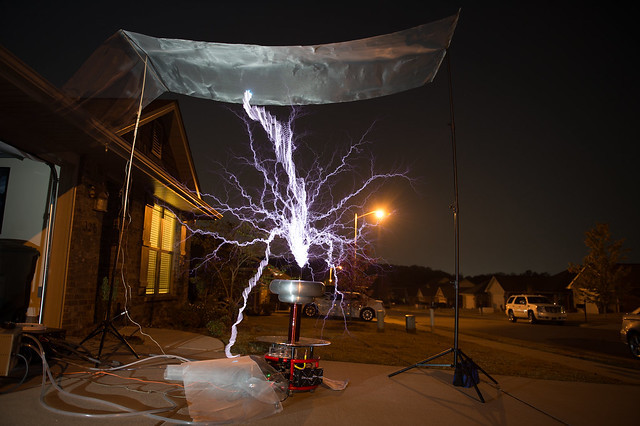
~2.4m!
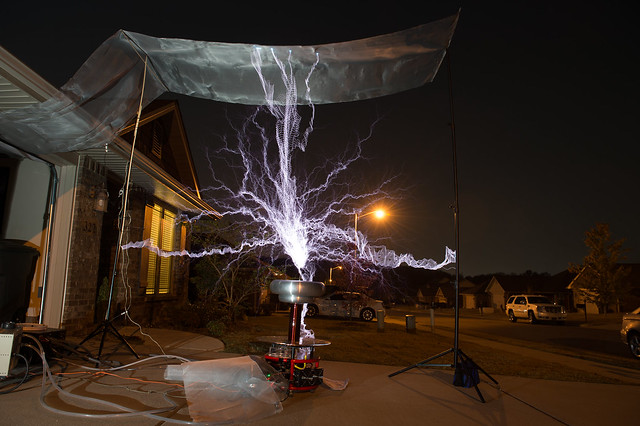
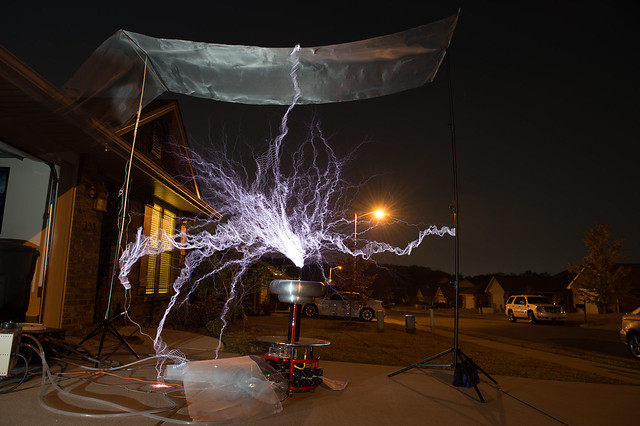
Phillip Slawinski, Sun Nov 20 2016, 09:45PM
I finally got ahold of some more video form the event.
And some photos... thanks to John Forcina for both.

~2.4m!


Re: DRSSTC V ( now "Skinny Coil" )
Intra, Thu Oct 11 2018, 04:41PM
How much cycles of startup oscillator this coil have?
Intra, Thu Oct 11 2018, 04:41PM
How much cycles of startup oscillator this coil have?
Re: DRSSTC V ( now "Skinny Coil" )
Phillip Slawinski, Fri Oct 12 2018, 01:50AM
Two. The coil runs at F0, so probably it would be okay with just one startup cycle.
Phillip Slawinski, Fri Oct 12 2018, 01:50AM
Intra wrote ...
How much cycles of startup oscillator this coil have?
How much cycles of startup oscillator this coil have?
Two. The coil runs at F0, so probably it would be okay with just one startup cycle.
Re: DRSSTC V ( now "Skinny Coil" )
Intra, Fri Oct 12 2018, 08:37AM
I thought startup oscillator was created for holding coil startup at higher pole when primary tuned on lower until streamer capacitance will not drop resonant frequency.
Intra, Fri Oct 12 2018, 08:37AM
Phillip Slawinski wrote ...
Two. The coil runs at F0, so probably it would be okay with just one startup cycle.
Why then startup oscillator is needed if coil runs at lower pole?Intra wrote ...
How much cycles of startup oscillator this coil have?
How much cycles of startup oscillator this coil have?
Two. The coil runs at F0, so probably it would be okay with just one startup cycle.
I thought startup oscillator was created for holding coil startup at higher pole when primary tuned on lower until streamer capacitance will not drop resonant frequency.
Re: DRSSTC V ( now "Skinny Coil" )
Phillip Slawinski, Fri Oct 12 2018, 11:22PM
The startup oscillator can be used to force a coil to oscillate at the upper pole, but it's also used to just get the coil oscillating in the first place. It also ensures that the switching isn't 'wrong' on the first half cycle like you get with inductor phase lead drivers.
Phillip Slawinski, Fri Oct 12 2018, 11:22PM
Intra wrote ...
Why then startup oscillator is needed if coil runs at lower pole?
I thought startup oscillator was created for holding coil startup at higher pole when primary tuned on lower until streamer capacitance will not drop resonant frequency.
Why then startup oscillator is needed if coil runs at lower pole?
I thought startup oscillator was created for holding coil startup at higher pole when primary tuned on lower until streamer capacitance will not drop resonant frequency.
The startup oscillator can be used to force a coil to oscillate at the upper pole, but it's also used to just get the coil oscillating in the first place. It also ensures that the switching isn't 'wrong' on the first half cycle like you get with inductor phase lead drivers.
Print this page